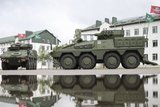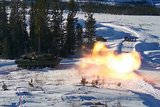Oshkosh to reset US Army M-ATV fleet
Oshkosh has won a contract from the US Army to reset its Mine Resistant Ambush Protected (MRAP) All-Terrain Vehicles (M-ATVs), the company announced on 5 February.
The programme to reset 800 Oshkosh-made MRAP M-ATVs will help the army standardise its M-ATV fleet configuration and achieve 100% mission readiness of its primary MRAP platform.
Oshkosh won a reset contract for 500 M-ATVs on 6 August 2014 and three additional contract options for 100 M-ATVs each on 12 December. It has already begun deliveries of the reset vehicles and will continue to deliver them up to September 2015.
The reset process for M-ATVs begins with a comprehensive vehicle configuration and condition inspection. After this, the company completes repairs, replaces missing parts and installs the necessary upgrade kits to match the current configuration of each M-ATV variant in the enduring fleet. These kits include automatic fire extinguishing systems, an underbody improvement kit and other safety-related improvements and more.
John Bryant, senior vice president, defence programmes, Oshkosh Defense, said: 'The M-ATV reset programme will ensure that all soldiers operating in M-ATVs will have fully-capable, mission-ready vehicles with all of the latest protection and technologies.'
Related Equipment in Defence Insight
More from Land Warfare
-
![2025 land market review: British Army woes, European heavy armour and US MBT progress]()
2025 land market review: British Army woes, European heavy armour and US MBT progress
The last year has seen several major procurements in the land market. Shephard’s Dr Peter Magill reviews the main trends and themes in land procurement of 2025.
-
![Hungary set to begin using Hero 400 loitering munitions]()
Hungary set to begin using Hero 400 loitering munitions
Developed by Israel's Uvision and with systems being sold in the thousands to multiple European NATO countries and the US, the Hero family of loitering systems is also in production in the US and Italy, the latter through Rheinmetall.
-
![Croatia orders Leopards and CAESAR howitzers as Lithuania orders more CAESARs]()
Croatia orders Leopards and CAESAR howitzers as Lithuania orders more CAESARs
The Leopard is becoming the tank of choice in central and eastern Europe as Croatia joins Lithuania, the Czech Republic and Hungary in ordering the platform. Lithuania and Croatia have also signed for CAESAR howitzers.
-
![Light Reconnaissance Strike – enabling a vital mission set (Studio)]()
Light Reconnaissance Strike – enabling a vital mission set (Studio)
A new system-of-systems concept will unlock digital integration of sensors and weapons for Light Forces, allowing them to shape the battlefield environment on their own terms and upgrade legacy platforms.

























